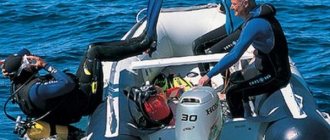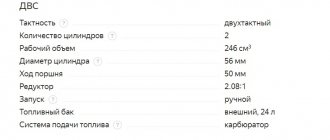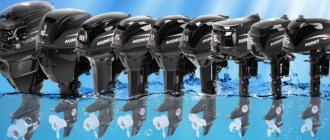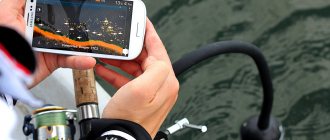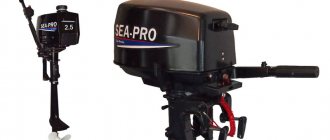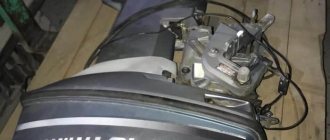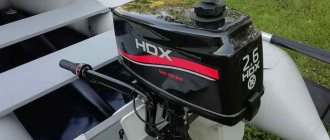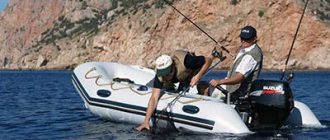The question of fuel consumption by a boat engine falls into the category that interests many owners of small boats.
When purchasing such an engine, a potential buyer is most often interested in data about its cost, boat speed and fuel consumption.
And if the issue of cost is decided at the place where the motor is purchased, and the speed depends on the type of boat and motor power, then data on fuel consumption is much more difficult to obtain.
Unlike cars, for which fuel consumption is measured in liters per 100 km traveled, the fuel consumption of a boat engine is measured differently.
A car is developed for a specific engine and fuel consumption depends only on the engine-body combination, which remains unchanged throughout the entire period of its operation.
In addition, the heavy weight of the car and solid engine power minimize the influence of weather conditions, the weight of passengers and luggage.
As for boats equipped with two- or four-stroke power plants, when moving on the water surface, they are exposed to a large number of different factors.
In addition to the type and weight of the boat on which the motor is mounted, fuel consumption is significantly affected by :
- Headwind or tailwind.
- Moving with or against the current.
- Boat load.
- Driving mode – planing or displacement.
Examples of consumption from various manufacturers
Examples of hourly and specific fuel consumption by boat power plants of various brands are given in many specialized publications and on numerous websites of companies selling this type of product.
They are presented in the form of tables or graphs compiled from the results of testing a large number of a wide variety of engines.
These data, without claiming to be the truth in the first instance, can help the owner of a boat motor determine the amount of fuel that needs to be taken with them when going fishing or traveling.
Let's look at the statistics of the most popular motors, such as:
Yamaha
Two-stroke:
- Power range , hp: 2.5…30.
- Range of changes in fuel consumption, l/hour: from 1.7 to 11.5.
Four-stroke:
- Power range , hp: 4…40.
- Range of changes in fuel consumption, l/hour: from 1.7 to 14.5.
Mercury
Two-stroke:
- Power range , hp: 2.5…40.
- Range of changes in fuel consumption, l/hour: from 1.5 to 17.
Four-stroke:
- Power range , hp: 2.5…30.
- Range of changes in fuel consumption, l/hour: from 1 to 10.
Suzuki
Two-stroke:
- Power range , hp: 15…40.
- Range of changes in fuel consumption, l/hour: from 3.47 to 9.24;
Four-stroke:
- Power range , hp: 2.5…40.
- Range of changes in fuel consumption, l/hour: from 0.5 to 6.6.
Tohatsu
Fuel consumption of Mercury and Tohatsu (two-stroke)
Two-stroke:
- Power range , hp: 2.5…40.
- Range of changes in fuel consumption, l/hour: from 1.7 to 17.
Four-stroke:
- Power range , hp: 2.5…30.
- Range of changes in fuel consumption, l/hour: from 1.2 to 10.
Engine reviews
Boat owners who chose a 40 hp Yamaha engine speak positively about the equipment of the Japanese manufacturer. Among the advantages are quiet operation, low fuel and oil consumption, excellent operation of control systems and overheating protection.
The main disadvantage is the price of motors and spare parts for them. However, it is better to pay once for high-quality equipment and forget about engine problems for many years, than to give preference to cheap, but less reliable analogues.
Fuel consumption of two-stroke engines
The domestic market offers fans of fishing and motorboating two-stroke engines that do not have the disadvantages of carburetor engines of previous years.
Today, well-known manufacturers (Evinrude, Mercury Marine, etc.) equip their engines with modern direct fuel injection systems.
Direct injection of a certain amount of fuel into the combustion chamber of each cylinder ensures its complete combustion with virtually no losses.
However, in order to further reduce fuel consumption, especially at low speeds (main operating mode), manufacturers have developed a stratified injection system.
By using the on-board computer to determine how much energy is needed to move the boat, this innovative system delivers only the required amount of fuel to the engine.
Considering that the system operates in real time, and engine power is not significant, very efficient use of fuel at low speeds is achieved.
Two-stroke internal combustion engine!
Hello friends!
Today we continue to consider the principle of operation of the internal combustion engine. Last time we studied the principle of operation of a four-stroke engine. In two-stroke engines, all operating cycles (the processes of inlet of the fuel mixture, exhaust gases, purge) occur during one revolution of the crankshaft in two main strokes. Engines of this type do not have valves; their role is played by a piston, which, when moving, closes the intake, exhaust and purge windows. Therefore, they are simpler in design. The power of a two-stroke engine with the same cylinder dimensions and shaft speed is theoretically twice that of a four-stroke engine due to the greater number of operating cycles. However, incomplete use of the piston stroke for expansion, worse release of the cylinder from residual gases and costs
The engine consists of a crankcase in which the crankshaft and cylinder are mounted on bearings on both sides. A piston moves inside the cylinder - a metal cup surrounded by spring rings (piston rings) inserted into grooves on the piston. Piston rings prevent gases generated during fuel combustion from passing between the piston and the cylinder walls. The piston is equipped with a metal rod - a pin; it connects the piston to the connecting rod. The connecting rod transmits the linear reciprocating motion of the piston into the rotational motion of the crankshaft. All rubbing surfaces and bearings inside two-stroke engines are lubricated using a fuel mixture into which the required amount of oil is mixed. The fuel mixture enters both the crank chamber of the engine - this is the cavity where the crankshaft is fixed and rotates - and into the cylinder. There is no lubricant there anywhere, and even if there was, it would have been washed away by the fuel mixture. This is the reason why oil is added in a certain proportion to gasoline. The type of oil used is special, specifically for two-stroke engines. It must withstand high temperatures and, when burned together with the fuel, leave a minimum of ash deposits.
1. Compression stroke
. The piston moves from the bottom dead center of the piston (in this position the piston is at the bottom dead center, hereinafter we call this position for short BDC) to the top dead center of the piston (hereinafter TDC), blocking first the purge and then the exhaust window. After the piston closes the exhaust window in the cylinder, compression of the combustible mixture that previously entered it begins. At the same time, in the crank chamber, due to its tightness and after the piston closes the purge windows, a vacuum is created under the piston, under the influence of which a combustible mixture enters the crank chamber from the carburetor through the inlet window and the slightly open valve.
2. Power stroke
. When the piston is positioned near TDC, the compressed working mixture is ignited by an electric spark from the spark plug, as a result of which the temperature and pressure of the gases increase sharply. Under the influence of thermal expansion of gases, the piston moves to BDC, while the expanding gases perform useful work. At the same time, going down, the piston creates high pressure in the crank chamber (compressing the air-fuel mixture in it). Under the influence of pressure, the valve closes, thus preventing the combustible mixture from entering the intake manifold again and then into the carburetor. When the piston reaches the exhaust window, it opens and exhaust gases begin to be released into the atmosphere, the pressure in the cylinder decreases. With further movement, the piston opens the purge window and the combustible mixture compressed in the crank chamber flows through the channel, filling the cylinder and purging it of exhaust gas residues. Ignition principle. Since the fuel mixture takes time to ignite, the spark appears at the plug a little earlier than the piston reaches TDC. Ideally, the faster the piston moves, the earlier the ignition should be, because the piston reaches TDC faster from the moment of spark. There are mechanical and electronic devices that change the ignition angle depending on engine speed. Almost for scooters before 2000. There were no such systems and the ignition timing was set based on optimal speed. Advantages of two-stroke engines:
Fuel consumption of four-stroke engines
When choosing a four-stroke outboard motor, fuel consumption is also of no small importance.
Recently, the manufacturers of these engines have managed to solve a number of problems that have a certain impact on this parameter.
Among them:
- Insufficient maximum torque at low speeds.
- Delayed throttle response.
These problems were solved by using the latest scientific achievements in the design of boat engines.
Currently, almost all manufacturers equip their four-stroke power plants with computer electronic systems:
- Throttle control.
- Shifting gears.
Leading manufacturers are actively introducing original systems of their own design into production.
Equipping the engines allows you to ensure efficient use of fuel:
- Mercury Verado - electronic variable valve timing system.
- Honda - electronic valve control system.
In addition, leading manufacturers install direct injection systems in four-stroke engines, similar to those used in two-stroke engines.
At the same time, research in the field of increasing fuel efficiency continues.
Suuzuki company:
- Uses an injection system that operates without a battery.
- She has developed an innovative technological process for using lean mixture in low-power power plants (up to 20 hp).
Honda has developed the original LEANburn Control fuel supply system. This allows engines equipped with such a system to automatically determine the optimal composition of the fuel-air mixture for any change in thrust.
Thus, savings of up to 25% are achieved.
However, the use of computer systems has to some extent complicated the already quite complex maintenance of four-stroke engines.
If the owner can change the oil and filters himself, then all other operations should be performed by a qualified mechanic.
Choosing a boat motor
- Economical consumption. Of course, total fuel consumption plays an important role. It is best to choose a model so that its consumption is not too large, but not too small. In this case, the structure will serve for quite a long time, and you won’t have to pay very much money for it.
- Low noise level. Here in first place are, as mentioned above, 4-stroke engines. They do not consume too much fuel and are practically silent. Two-stroke engines are quite loud, especially if the engine is carburetor. The least amount of noise will come from an injection four-stroke outboard engine.
- Environmental friendliness. This indicator is very important, since they are not equipped with an exhaust pipe, so those in the boat will have to breathe the exhaust gases. In this regard, it is much better to have a minimum amount of gases, and their toxic component would be almost zero. The 4-stroke injection engine also fully meets these indicators.
- Ability to perform some maneuvers at speed. Some people buy motor boats for fishing or just for their own pleasure. The maneuverability of the vessel always plays a very important role. This indicator depends not only on the design of the boat itself, but also on the power and type of motor. In principle, most boat engines are capable of normal maneuvering on the water, but a carburetor four-stroke engine is considered the best.
We suggest you read: How to properly equip a float fishing rod
The choice of motor should always be based on the intended operating conditions. Every owner always understands what goals he is pursuing when purchasing a boat. Some people are interested in relaxing time on the water on weekends, some are interested in long fishing trips, others want to feel the adrenaline rush while rafting down the river at maximum speed. Purchasing a certain type of engine can provide some positive benefits:
- economical consumption;
- low noise level;
- environmental friendliness;
- the ability to perform some maneuvers at speed;
- safety.
In order for your motor to meet the most of these points, it must be suitable for the type of boat you have. A motor that is too powerful will weigh more, thereby weighing down the stern or bow of your boat. This may adversely affect the boat's stability when turning. With slight disturbances of the water there will be a risk of flooding, since the waterline will be low. In this regard, it is strongly recommended not to select the maximum permissible amount of power, which will only have a positive effect on the formation of waves and ripples on the water.
- A 2-stroke outboard motor is simpler in design, so it can be repaired even by the owner. It works flawlessly in all weather conditions, from sub-zero temperatures to heat of about 35 degrees. This allows us to characterize it as reliable. This motor does not require special conditions for transportation.
- A 4-stroke engine is more complex, so only a master can repair it. When transporting, you need to be careful not to tilt it; the exact position for transportation will be described in the motor instructions. It weighs more, but is quieter. Such engines are more popular in Europe, since the emissions of harmful substances are minimal here.
Outboard motor fuel consumption
Calculation of data characterizing fuel consumption by outboard boat motors is always quite subjective and relative.
Therefore, statistical indicators given in various publications often contradict each other.
It must be remembered that fuel consumption in boat engines is calculated in kg/hour, and it is sold at gas stations in liters.
Therefore, inattention at a gas station can lead to the fact that the fuel tank is empty somewhere in the middle of the pond. After all, the weight of 1 liter of gasoline, depending on the brand, is 0.71 - 0.76 kg.
Engine fuel consumption
The issue of engine fuel consumption is an eternal hot topic for almost all boaters. Calculating how much fuel your boat will consume is not so easy. Here, as mentioned, several important factors are at work. But there are obvious and well-known nuances that are very important to take into account:
- It is clear that you will immediately understand the issue of the cost of a particular boat unit when purchasing an engine. Its power, in turn, will depend on the type of specific small boat and the power of your inboard or outboard boat engine. But the information that will tell you how your boat burns is much more difficult to obtain;
- as you know, for motor vehicles, in which fuel consumption is measured in liters per 100 kilometers of travel, the fuel consumption of the engine for the boat will be measured in a completely different way;
- the machine is designed for one or another specific engine for water transport. That is why the combustion of fuel in it will depend on indicators such as the engine and the body, which interact with each other throughout the entire journey. Also, the large mass of the car and a sufficiently large motor power will minimize the influence of certain climatic data, as well as the mass of the cargo and those on board the boat;
- If we talk about two-stroke and four-stroke outboard engines, then it will be a completely different matter. When moving through water, they are influenced by a number of factors.
We recommend reading: Description of the Sea Pro outboard motor
Evgeniy Bronov
auto RU
Here are some of the important factors that have a significant influence on this issue: the wind, and it affects both the headwind and the tailwind that your ship meets, it is important whether you are moving with the current or against it, the workload of your boat is also important. transport and traffic mode. Boats have different types of propulsion, such as planing and displacement.
Also, in addition to these important factors that can radically change your path and the amount of fuel that will last you for some time, the type and weight of the boat on which the motor is directly attached is also important.
